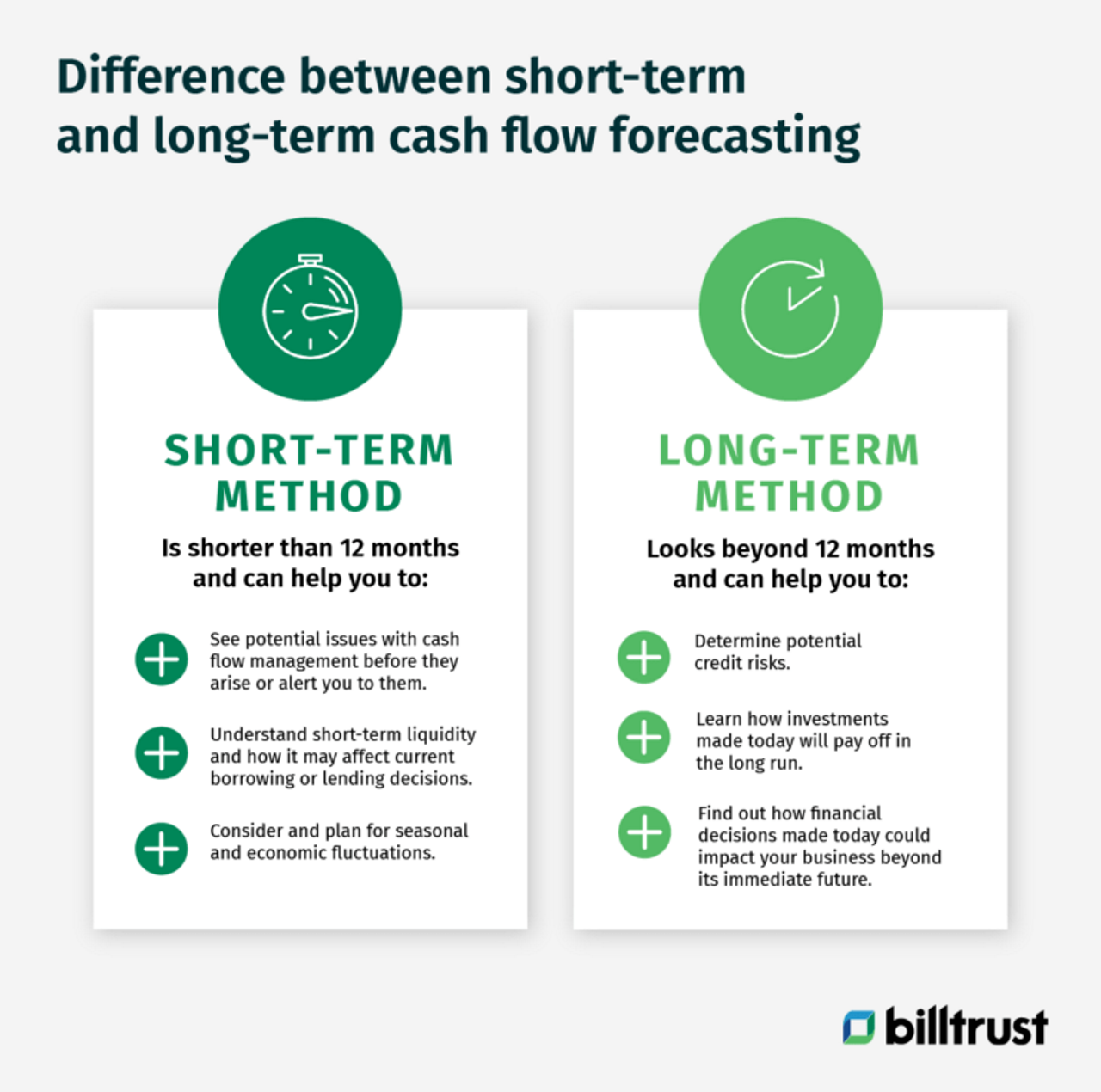This blog was originally published in May 2022 and was updated in October 2024 with more information about cash flow forecasting, including the benefits and drawbacks of short-term vs. long-term forecasting, how businesses can use forecasting to improve cash flow management, and more.
Cash flow forecasting projects your business’s financial future by estimating its cash flow in and out. Forecasting cash flows can help you avoid cash shortfalls and use surplus cash wisely. For example, you could expand your business to another location or buy more inventory. However, it would help to decide between short-term and long-term cash forecasting.
Forecasting helps your business’s growth because it guides financial and strategy decisions by leadership. Cash forecasting can help you to secure your business’s future and increase your bottom line along the way.
Keep reading to learn about short-term and long-term cash forecasting.

The purpose of forecasting short term and long term
If you wait until opportunities or issues happen within your business, it may lead to one or more of the following:
- Increased costs
- Decreased opportunities
- Loss of revenue and profits
- Employee strains
- Dissatisfied customers
A short-term forecast gives you a glimpse of your company’s immediate future (12 months or less) and can help you make business decisions quickly.
Using long-term forecasts and projections can help you see and uncover the potential problems that may emerge in your business in the future. A long-term forecast can also help you to identify growth opportunities. They allow you to become more proactive and strategic regarding operational objectives rather than reactive.
Read now → Strengthen your forecasting with insights on credit management [ Blog ]
What are the differences between short term and long term cash flow forecasting methods?

Short-term method
What is the short-term forecasting method? It estimates cash flow ins and outs for 12 months or less. A short-term forecast ranges from one week to 30 days, 60 days or 90 days into the future of your business. They’re also broken down into monthly or quarterly and then into weekly or bi-weekly periods. A short-term forecast can help your business to:
- See potential issues with cash flow management before they arise or alert you to them.
- Understand short-term liquidity and how it may affect current borrowing or lending decisions.
- Consider and plan for seasonal and economic fluctuations.
Long-term method
What is the long-term cash flow forecasting method? It’s a forecast that looks beyond 12 months and typically projects three years into the future. Because of this, it’s more significant than a short term forecast and can help you to:
- Determine potential credit risks.
- Learn how investments made today will pay off in the long run.
- Find out how financial decisions made today could impact your business beyond its immediate future.
Using long-term cash forecasting helps management make decisions of great significance. From this, they can create strategies to reach financial goals. However, long-term forecasting is usually used as a general guide to measuring your business’s current cash flow. Why? Because the further you look into the future, the better the accuracy of your projections.
Your business needs a first-rate forecasting method. After all, the overall success of your business depends on it. You may consider integrating short-term cash flow forecasting into long term cash forecasting to produce a more comprehensive predictive model.
Forecasting short-term vs. long-term: benefits, drawbacks, and preparation

Whether you use short-term or long-term forecasting in your business depends on many factors. For example, if you’ve considered expanding locations, you may want to see how much it may cost you. If you're going to expand your product line, you may want to consider the cost of additional inventory. For these and other reasons, it’s essential to choose the best forecasting method for your business. Let’s explore the benefits and drawbacks of short-term vs. long-term forecasting.
Benefits of short-term method
Remember that a short-term forecast focuses on 12 months or less, usually 30-90 days. Using this can provide you with many insights into your business and can help you do the following:
Apply scenario analysis
Scenario analysis is applied in corporate finance and also used to estimate the expected value of a portfolio after a specific period, assuming specific changes in the portfolio's value. It tests both likely and unlikely worst-case scenarios. This means you can use “what-if” events to avoid bankruptcy, economic uncertainty, etc.
Gauge financial health
Seeing the weaknesses in your business’s revenue cycle and any cash surpluses gives you a good overview of the financial health of your business.
Measure working capital management
Working capital management refers to a business’s current assets minus its liabilities. By effectively managing your working capital, you can reduce the need to borrow funds to cover operating expenses.
Drawbacks of short term method
While the short term method has benefits, it has the following drawbacks:
Error-ridden data
When data is pulled from multiple sources, human error may distort it. Errors create variances at a high level, resulting in a skewed outcome.
Large initial cost
If you want to leverage technology, it may cost your business more than what you expected. This is why some companies don’t perform forecasting regularly.
Predicting accounts receivable (AR) and accounts payable (AP)
Predicting AR and AP for the long term is challenging because your business may have a significant number of invoices, discounts, disputes, etc.
Slowed decision making
Many teams are involved in short term forecasting, including accounts payable and account receivable. Plus, it takes time to gather and sort data. Because of this, decision making becomes delayed, which may hurt your business.
How do you create a short term projection?
The method you choose to prepare your short term forecast will depend on your budget, quality of data and reason for preparing a short-term cash forecast. Once you know this, you may consider using one (or a combination) of the following:
- Bank data–Based on your business’s bank statements.
- Business intelligence and statistics–Uses historical data, projected sales, other known business drivers and factors, etc.
- Receipts and disbursements–Referred to as a working capital approach.
Read now → Protect your future cash flows by managing bad debt expenses [ Blog ]
Benefits of long term method
Remember that a long-term cash flow forecast is longer than 12 months. It gives you a good viewpoint of your business’s financial health, needs and availability of cash surpluses for investments in the future. Plus, knowing your financial analysis and planning (FP&A) goals can help you increase your business’s profitability.
Here are the benefits of long-term cash forecasting:
Accelerated cash flow and reserves
Having an idea about your business’s potential expenses and income in advance can help you manage your cash flow. It ensures that you have enough funds to pay suppliers and employees in the event of an unexpected large sale or order. Recognizing capital needs earlier allows you to increase or maintain your cash surpluses or apply for additional credit or loans.
Better staffing forecast
Considering your staffing needs allows you to hire more efficiently. It also helps reduce your labor costs and enhance the quality of your employees. If you react, you may reduce the quality of candidates. Plus, you may have less cash available or office space or equipment for new hires. Work with your human resources department to create an organization chart that outlines the business’s needs one year in advance to ensure you employ staff effectively.
Note: Financial analysts should review and investigate variances and make the necessary corrections immediately to minimize risks.
Enhanced production management
You can improve production by working with your sales department. Creating long-term demand forecasts can help you anticipate large orders or potential seasonal spikes. If this happens, you can have enough inventory to fulfill orders. However, you may also ask customers to take their orders over a longer period of time.
Note: Production management ensures your business has enough labor, materials, and supplies and that you have an efficient warehouse to ship orders quickly. It also allows you to conduct maintenance around peak times. Moving forward, you can include demand forecasting into your quarterly or yearly management activities.
Improved asset management
Reviewing your building, land, computer equipment, machinery, inventory, property, software and systems and other assets is imperative to your business. If these are in great shape, they can help your business maintain a high level of operational efficiency. Plus, if you want to sell or replace assets, you’ll be in a better position to do so by knowing your long-term needs.
Drawbacks of long term method
Accuracy decreases the more extended the forecast, which leads to the following drawbacks:
Economic concerns
You never know when an economic downturn may occur because of pandemics, market unpredictability, real estate and technology bubbles, etc. Because of this, long-term forecasts lose their reliability.
Huge initial costs
Like short-term cash forecasting, forecasting for the long term may cost you more than you expected. After all, you'll need the right team and technologies, which can add up. However, investing in automated forecasting software is an investment that can pay off in the long run.
Time-consuming and labor-intensive
Long-term forecasting requires intensive data gathering, organizing, coordination, and analysis. If you hire a team of planners, they’ll need to collaborate with your finance, marketing, and sales departments. Plus, data processes may be manual, labor intensive, and even granular. The amount of time spent on long term forecasting may reduce the amount of time spent on day-to-day operations.
Weak historic information
If your business doesn’t have accurate historical data, your projections will reflect it. Without sufficient historical information, your company may suffer financially.
How do you create a long term projection?
To create a long-term forecast, your financial analyst will use the adjusted net income (ANI) method and pull data from the company’s budgets. ANI tracks changes in working capital and anticipates the financial needs of your business, but it doesn’t follow individual cash flows. Regardless, it’s essential to show how cash flows impact your business.
Stimulate your cash flow management with short-term and long-term forecasting
Finance leaders know the importance of choosing the correct forecasting technique for a business. In fact, you may decide to use both the short term and long term cash forecasting methods to get a more comprehensive look at the financial landscape. Furthermore, to help generate more consistent cash flow, you may consider implementing AR automation software. Not only can it accelerate your cash application efforts, but it can also drive your accounts receivable team’s performance through robust reporting. Your business may expand sooner than you thought expected.
Read now → Optimize your collections with the collection effectiveness index [ Blog ]

